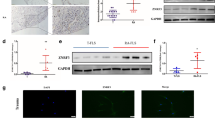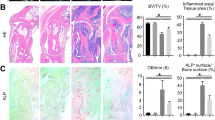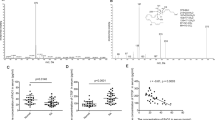Abstract
This work aims to discuss the possibility that disordered CUL4B was involved in the pathogenesis of adjuvant-induced arthritis (AIA) in rats. Synovium and FLS from AIA rats both showed increased CUL4B and β-catenin, and up-regulated CUL4B enhanced the canonical Wnt signaling by targeting the GSK3β. Increased CUL4B promoted the FLS abnormal proliferation, activated the secretion of IL-1β and IL-8, and promoted the production of AIA pathology gene MMP3 and fibronectin. Furthermore, miR-101-3p was significantly down-regulated in AIA rats compared with controls, and transfection of AIA FLS with miR-101-3p mimics significantly down-regulated the CUL4B expression, whereas transfection with miR-101-3p inhibitors resulted in an opposite observation. The dual-luciferase reporter assay confirmed that the CUL4B was a direct target of miR-101-3p, and further analysis suggested that lowly expressed miR-101-3p contributed to disordered CUL4B activating the canonical Wnt signaling pathway and further promoting the development of AIA rats. Thus clarification of the CUL4B roles in the pathogenesis of AIA rats and corresponding mechanisms will contribute to the disease diagnosis and treatment for rheumatoid arthritis (RA) patients.
Key messages
-
CUL4B expression is up-regulated in synovium and FLS from AIA rats.
-
Increased CUL4B promotes the canonical Wnt signaling.
-
Increased CUL4B promotes the pathogenesis of AIA rats.
-
Decreased miR-101-3p contributes to disordered CUL4B.














Similar content being viewed by others
Abbreviations
- RA:
-
rheumatoid arthritis
- CUL4B:
-
Cullin 4B
- AIA:
-
adjuvant-induced arthritis
- RING:
-
really interesting new gene
- CRLs:
-
Cullin-RING ubiquitin ligase
- PRC2:
-
polycomb repressive complex 2
- MTT:
-
3-(4,5-dimethylthiazol-2-yl)-2,5-diphenyltetrazoliumbromide
- DMSO:
-
dimethyl sulfoxide
- FBS:
-
fetal bovine serum
- WDR5:
-
WD repeat containing protein5
- PrxIII:
-
peroxiredoxin III
- SDF-1:
-
stromal cell derived factor 1
References
Vriend J, Reiter RJ (2016) Elatonin, bone regulation and the ubiquitin–proteasome connection: a review. Life Sci 145:152–160
Vittal V, Stewart MD, Brzovic PS, Klevit RE (2015) Regulating the regulators: recent revelations in the control of E3 ubiquitin ligases. J Biol Chem 290:21244–21251
Hadchouel J, Ellison DH, Gamba G (2016) Regulation of renal electrolyte transport by WNK and SPAK-OSR1 kinases. Annu Rev Physiol 78:367–389
Lampert F, Brodersen MM, Peter M (2017) Guard the guardian: a CRL4 ligase stands watch over histone production. Nucleus 8:134–143
Antonioli M, Di Rienzo M, Piacentini M, Fimia GM (2017) Emerging mechanisms in initiating and terminating autophagy. Trends Biochem Sci 42:28–41
Wang X, Chen Z (2016) Knockdown of CUL4B suppresses the proliferation and invasion in non-small cell lung cancer cells. Oncol Res 24:271–277
Hu H, Yang Y, Ji Q, Zhao W, Jiang B, Liu R, Yuan J, Liu Q, Li X, Zou Y, Shao C, Shang Y, Wang Y, Gong Y (2012) CRL4B catalyzes H2AK119 monoubiquitination and coordinates with PRC2 to promote tumorigenesis. Cancer Cell 22:781–795
Mi J, Zou Y, Lin X, Lu J, Liu X, Zhao H, Ye X, Hu H, Jiang B, Han B, Shao C, Gong Y (2017) Dysregulation of the miR-194-CUL4B negative feedback loop drives tumorigenesis in non-small-cell lung carcinoma. Mol Oncol 11:305–319
Qu Z, Li D, Xu H, Zhang R, Li B, Sun C, Dong W, Zhang Y (2016) CUL4B, NEDD4, and UGT1As involve in the TGF-β signalling in hepatocellular carcinoma. Ann Hepatol 15:568–576
Chen P, Yao GD (2016) The role of cullin proteins in gastric cancer. Tumour Biol 37:29–37
Bluett J, Barton A (2017) Precision medicine in rheumatoid arthritis. Rheum Dis Clin N Am 43:377–387
van Drongelen V, Holoshitz J (2017) Human leukocyte antigen–disease associations in rheumatoid arthritis. Rheum Dis Clin N Am 43:363–376
Knevel R, Huizinga TWJ, Kurreeman F (2017) Genomic influences on susceptibility and severity of rheumatoid arthritis. Rheum Dis Clin N Am 43:347–361
Sapir-Koren R, Livshits G (2017) Postmenopausal osteoporosis in rheumatoid arthritis: the estrogen deficiency-immune mechanisms link. Bone 103:102–115
Laufer VA, Chen JY, Langefeld CD, Bridges SL Jr (2017) Integrative approaches to understanding the pathogenic role of genetic variation in rheumatic diseases. Rheum Dis Clin N Am 43:449–466
Hannah J, Zhou P (2015) Distinct and overlapping functions of the cullin E3 ligase scaffolding proteins CUL4A and CUL4B. Gene 573:33–45
Abd El-Rahman RS, Suddek GM, Gameil NM, El-Kashef HA (2011) Protective potential of MMR vaccine against complete Freund’s adjuvant-induced inflammation in rats. Inflammopharmacology 19:343–348
Mbiantcha M, Almas J, Shabana SU, Nida D, Aisha F (2017) Anti-arthritic property of crude extracts of Piptadeniastrum africanum (Mimosaceae) in complete Freund’s adjuvant-induced arthritis in rats. BMC Complement Altern Med 17:111–127
Alam J, Jantan I, Bukhari SNA (2017) Rheumatoid arthritis: recent advances on its etiology, role of cytokines and pharmacotherapy. Biomed Pharmacother 92:615–633
Yuan FL, Li X, Xu RS, Jiang DL, Zhou XG (2014) DNA methylation: roles in rheumatoid arthritis. Cell Biochem Biophys 70:77–82
Angelotti F, Parma A, Cafaro G, Capecchi R, Alunno A, Puxeddu I (2017) One year in review 2017: pathogenesis of rheumatoid arthritis. Clin Exp Rheumatol 35:368–378
Kim KW, Cho ML, Kim HR, Ju JH, Park MK, Oh HJ, Kim JS, Park SH, Lee SH, Kim HY (2007) Up-regulation of stromal cell-derived factor 1 (CXCL12) production in rheumatoid synovial fibroblasts through interactions with T lymphocytes: role of interleukin-17 and CD40L–CD40 interaction. Arthritis Rheum 56:1076–1086
Li Y, Wang LM, Xu JZ, Tian K, Gu CX, Li ZF (2017) Gastrodia elata attenuates inflammatory response by inhibiting the NF-κB pathway in rheumatoid arthritis fibroblast-like synoviocytes. Biomed Pharmacother 85:177–181
Sertic S, Evolvi C, Tumini E, Plevani P, Muzi-Falconi M, Rotondo G (2013) Non-canonical CRL4A/4B(CDT2) interacts with RAD18 to modulate post replication repair and cell survival. PLoS One 8:e60000
Li X, Lu D, He F, Zhou H, Liu Q, Wang Y, Shao C, Gong Y (2011) Cullin 4B protein ubiquitin ligase targets peroxiredoxin III for degradation. J Biol Chem 286:32344–32354
Sharifi HJ, Furuya AK, Jellinger RM, Nekorchuk MD, de Noronha CM (2014) Cullin4A and cullin4B are interchangeable for HIV Vpr and Vpx action through the CRL4 ubiquitin ligase complex. J Virol 88:6944–6958
Sarikas A, Hartmann T, Pan ZQ (2011) The cullin protein family. Genome Biol 12:220–228
Shen E, Shulha H, Weng Z, Akbarian S (2014) Regulation of histone H3K4 methylation in brain development and disease. Philos Trans R Soc Lond Ser B Biol Sci 369:1652
Daud M, Rana MA, Husnain T, Ijaz B (2017) Modulation of Wnt signaling pathway by hepatitis B virus. Arch Virol doi 162:2937–2947
Kaneko H, Terasaki H (2017) Biological involvement of MicroRNAs in proliferative vitreoretinopathy. Transl Vis Sci Technol 6:5–13
Rajman M, Schratt G (2017) MicroRNAs in neural development: from master regulators to fine-tuners. Development 144:2310–2322
Awan HM, Shah A, Rashid F, Shan G (2017) Primate-specific long non-coding RNAs and microRNAs. Genomics Proteomics Bioinformatics 15:187–195
Yan Y, Wang R, Guan W, Qiao M, Wang L (2017) Roles of microRNAs in cancer associated fibroblasts of gastric cancer. Pathol Res Pract 213:730–736
Author information
Authors and Affiliations
Corresponding author
Ethics declarations
Conflict of interest statement
The authors declare no competing interests.
Rights and permissions
About this article
Cite this article
Miao, C., Chang, J., Zhang, G. et al. CUL4B promotes the pathology of adjuvant-induced arthritis in rats through the canonical Wnt signaling. J Mol Med 96, 495–511 (2018). https://doi.org/10.1007/s00109-018-1635-8
Received:
Revised:
Accepted:
Published:
Issue Date:
DOI: https://doi.org/10.1007/s00109-018-1635-8




